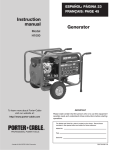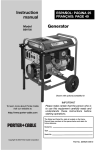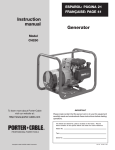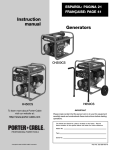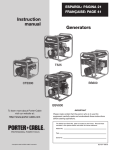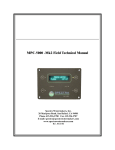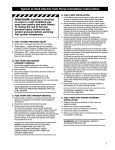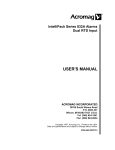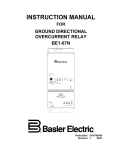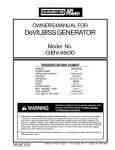Download PYLE Audio BSV750 User's Manual
Transcript
ESPAÑOL: PÁGINA 23 FRANÇAIS: PAGE 45 Instruction manual Generator Model BSV750 Shown with optional portability kit To learn more about Porter-Cable visit our website at: http://www.porter-cable.com IMPORTANT Please make certain that the person who is to use this equipment carefully reads and understands these instructions before starting operations. The Model and Serial No. plate is located on the frame. Record these numbers in the spaces below and retain for future reference. Model No. PROFESSIONAL POWER TOOLS Type Serial No. Copyright © 2000 PORTER-CABLE Corporation Part No. D24130-023-1 SPECIFICATION MODEL HORSE POWER RATED/SURGE WATTS VOLTAGE AMPERAGE PHASE FREQUENCY ENGINE SPEED MAX. AMBIENT TEMP. FUEL CAPACITY RUN TIME @ 50%/100% BSV750 13 7500/10,750 120/240 62.5/31.25 SINGLE 60 Hz 3600 RPM 104° F 7 GALLON 9.4/5.4HRS product is not equipped with a spark arresting muffler. If the product will be used around • This flammable materials, or on land covered with materials such as agricultural crops, forest, brush, grass, or other similar items, then an approved spark arrester must be installed and is legally required in the state of California. It is a violation of California statutes section 130050 and/or sections 4442 and 4443 of the California Public Resources Code, unless the engine is equipped with a spark arrestor, as defined in section 4442, and maintained in effective working order. Spark arresters are also required on some U. S. Forest service land and may also be legally required under other statutes and ordinances. • This product may contain chemicals known to the state of California to cause cancer, birth defects, or other reproductive harm. This warning is given in compliance with California Proposition 65, as detectable amounts of chemicals subject to proposition 65 may be contained in this product. 2 — ENG WARRANTY PORTER-CABLE CORPORATION warrants to the original purchaser that each new electric generator and service part is free from defects in material and workmanship, and agrees to repair or replace under this warranty any defective product or part as follows from the original date of purchase. 2 YEARS – Limited warranty on electric generator alternators and 1 year limited warranty on all other parts. 90 Days – Service parts Engine warranties are the responsibility of the engine manufacturer. Warranties of merchandise sold by Porter-Cable which has been manufactured by and identified as the product of another company are the responsibility of the manufacturer of that product. THIS WARRANTY IS NOT TRANSFERABLE AND DOES NOT COVER Products sold damaged or incomplete, sold “as is,” sold reconditioned, or used as rental equipment. Delivery, installation, or normal adjustments explained in the owner’s manual. Damage or liability caused by shipping, improper handling, improper installation, improper maintenance, improper modification, or the use of accessories and/or attachments not specifically recommended by PORTER-CABLE for the product. Repairs necessary because of operator abuse or negligence, or the failure to install, operate, maintain, and store the product according to the instructions in the owner’s manual. Damage caused by cold, heat, rain, excessive humidity, corrosive environments and materials, or other contaminants. Expendable items that become worn during normal use such as fuel filters, air cleaners, spark plugs, and engine oil. Cosmetic defects that do not interfere with product functionality. Freight costs from customer to Porter-Cable. Repair and transportation costs of products or parts determined not to be defective. ANY INCIDENTAL, INDIRECT OR CONSEQUENTIAL LOSS, DAMAGE, OR EXPENSE THAT MAY RESULT FROM ANY DEFECT, FAILURE OR MALFUNCTION OF THE PRODUCT. Some states do not allow the exclusion or limitation of incidental or consequential damages, so the above limitation or exclusion may not apply to you. IMPLIED WARRANTIES, INCLUDING THOSE OF MERCHANTABILITY AND FITNESS FOR A PARTICULAR PURPOSE, ARE LIMITED TO ONE YEAR FROM THE DATE OF ORIGINAL PURCHASE. Some states do not allow limitations on how long an implied warranty lasts, so the above limitations may not apply to you. WARRANTY SERVICE is available by delivering or shipping the defective product or part to any Porter-Cable authorized warranty service location. To determine the nearest authorized warranty service location, call the toll free number, 1-888559-8550, 24 hours a day, 7 days a week. Specific instructions regarding servicing arrangements and scheduling may vary depending on the type and size of the product and the availability of repair parts. DO NOT return the defective product to the retailer. Retain the original cash register sales receipt as proof of purchase for warranty work. Purchasers should contact Porter-Cable directly if they do not receive satisfactory results from the authorized warranty service center. Porter-Cable Corporation 4825 Highway 45 North P.O. Box 2468 Jackson, TN 38302-2468 1-888-559-8550 3 — ENG SAFETY GUIDELINES - DEFINITIONS This manual contains information that is important for you to know and understand. This information relates to protecting YOUR SAFETY and PREVENTING EQUIPMENT PROBLEMS. To help you recognize this information, we use symbols to the right. Please read the manual and pay attention to these sections. URGENT SAFETY INFORMATION - A HAZARD THAT WILL CAUSE SERIOUS INJURY OR LOSS OF LIFE. Information for preventing damage to equipment. IMPORTANT SAFETY INFORMATION - A HAZARD THAT MIGHT CAUSE SERIOUS INJURY OR LOSS OF LIFE. Information that you should pay special attention to. IMPORTANT SAFETY INSTRUCTIONS • SAVE THESE INSTRUCTIONS • When using this product basic pre cautions should always be followed including the following: RISK OF ELECTROCUTION AND FIRE HAZARD Attempting to connect generator directly to the electrical system of any building structure. WHAT COULD HAPPEN HOW TO PREVENT IT Back feeding electricity through a building’s electrical system to the outside utility feed lines could en-danger repair persons attempting to restore service. Never backfeed electricity through a structure's electrical system. Attempting to connect to the incoming utility service could result in electrocution. To connect to a structure's electrical system in a safe manner, always have a Double-Throw Transfer Switch installed by a qualified electrician and in compliance with local ordinances. (When installing a Double-Throw Transfer Switch, a minimum of 10 gauge wiring must be used.) Restoration of electrical service while the generator is connected to the incoming utility could result in a fire or serious damage if an isolator switch is not installed. Failure to use a double throw transfer switch when connecting to a structure's electrical system can damage appliances and WILL VOID the manufacturer's warranty. 4 — ENG READ AND UNDERSTAND ALL WARNINGS BEFORE ATTEMPTING TO OPERATE GENERATOR. RISK OF ELECTROCUTION AND FIRE (cont’d) WHAT COULD HAPPEN HOW TO PREVENT IT Operation of generator in rain, wet, icy, or flooded conditions. Water is an excellent conductor of electricity! Water which comes in contact with electrically charged components can transmit electricity to the frame and other surfaces, resulting in electrical shock to anyone contacting them. Operate generator in a clean, dry, well ventilated area. Make sure hands are dry before touching unit. Use of worn, damaged, undersized or ungrounded extension cords. Contact with worn or damaged extension cords could result in electrocution. Inspect extension cords before use and replace with new cord if required. Use of undersize extension cords could result in overheating of the wires or attached items, resulting in fire. Use proper size (wire gauge) cordset for application see chart in the Assembly section of this manual. Use of ungrounded cordsets could prevent operation of circuit breakers and result in electrical shock. Always use a cordset having a grounding wire with an appropriate grounding plug. DO NOT use an ungrounded plug. Placing generator on or against highly conductive surface, such as a steel walkway or metal roof. Accidental leakage of electrical current could charge conductive surfaces in contact with the generator. Place generator on low conductivity surface such as a concrete slab. ALWAYS operate generator a minimum of six feet from any conductive surface. Improper connection of items to generator. Exceeding the load capacity of the generator by attaching too many items, or items with very high load ratings to it could result in overheating of some items or their attachment wiring resulting in fire or electrical shock. Read the load rating chart and instructions in the Wattage Calculation section. Make sure that the summation of electrical loads for all attachments does not exceed the load rating of the generator. Operation of unit when damaged, or with guards or panels removed. Attempting to use the unit when it has been damaged, or when it is not functioning normally could result in fire or electrocution. Do not operate generator with mechanical or electrical problem. Have unit repaired by an Authorized Service Center. Removal of guarding could expose electrically charged components and result in electrocution. Do not operate generator with protective guarding removed. HAZARD 5 — ENG READ AND UNDERSTAND ALL WARNINGS BEFORE ATTEMPTING TO OPERATE GENERATOR. RISK OF FIRE HAZARD WHAT COULD HAPPEN Attempting to fill the fuel tank while Gasoline and gasoline vapors can the engine is running. become ignited by coming in contact with hot components such as the muffler, engine exhaust gases, or from an electrical spark. HOW TO PREVENT IT Turn engine off and allow it to cool before adding fuel to the tank. Equip area of operation with a fire extinguisher certified to handle gasoline or fuel fires. Sparks, fire, hot objects Cigarettes, sparks, fires, or other hot objects can cause gasoline or gasoline vapors to ignite. Add fuel to tank in well ventilated area. Make sure there are no sources of ignition near the generator. Improper storage of fuel Improperly stored fuel could lead to accidental ignition. Fuel improperly secured could get into the hands of children or other unqualified persons. Store fuel in a OSHA approved container designed to hold gasoline. Store container in secure location to prevent use by others. Inadequate ventilation for generator Materials placed against or near the generator or operating the generator in areas where the temperature exceeds 104° F. ambient (such as storage rooms or garages) can interfere with its proper ventilation features causing overheating and possible ignition of the materials or buildings. Operate generator in a clean, dry, well ventilated area a minimum of four feet from any building, object or wall. DO NOT OPERATE UNIT INDOORS OR IN ANY CONFINED AREA. Tampering with factory set engine Engine speed has been factory set to provide safe operation. Tampering with speed settings. the engine speed adjustment could result in overheating of attachments and could cause a fire. Never attempt to “speed-up” the engine to obtain more performance. Both the output voltage and frequency will be thrown out of standard by this practice, endangering attachments and the user. Overfilling the fuel tank – fuel spillage. Use care in filling the tank to avoid spilling fuel. Make sure fuel cap is secured tightly and check engine for fuel leaks before starting engine. Move generator away from refueling area or any spillage before starting engine. Allow for fuel expansion. Keep maximum fuel level 1/2 inch below the tip of the fuel tank. Never refuel with the engine running. Spilled fuel and its vapors can become ignited from hot surfaces or sparks. 6 — ENG READ AND UNDERSTAND ALL WARNINGS BEFORE ATTEMPTING TO OPERATE GENERATOR. Risk of Injury and Property Damage When Transporting Generator HAZARD Fire, Inhalation, Damage to Vehicle Surfaces WHAT COULD HAPPEN Fuel or oil can leak or spill and could result in fire or breathing hazard, serious injury or death can result. Fuel or oil leaks will damage carpet, paint or other surfaces in vehicles or trailers. HOW TO PREVENT IT If generator is equipped with a fuel shut-off valve, turn the valve to the off position before transporting to avoid fuel leaks. If generator is not equipped with a fuel shut-off valve, drain the fuel from tank before transporting. Transport fuel only in an OSHA approved container. Always place generator on a protective mat when transporting to protect against damage to vehicle from leaks. Remove generator from vehicle immediately upon arrival at your destination. RISK OF BREATHING - INHALATION HAZARD HAZARD Gasoline engines produce toxic carbon monoxide exhaust fumes. WHAT COULD HAPPEN HOW TO PREVENT IT Breathing exhaust fumes will cause serious injury or death. Operate generator in clean, dry, well ventilated area. Never operate unit in enclosed areas such as garages, basements, storage, sheds, or in any location occupied by humans or animals. Keep children, pets and others away from area of operating unit. 7 — ENG READ AND UNDERSTAND ALL WARNINGS BEFORE ATTEMPTING TO OPERATE GENERATOR. RISK OF UNSAFE OPERATION HAZARD WHAT COULD HAPPEN Operation of generator in careless All sources of energy include the potential for injury. Unsafe operation or maintemanner. nance of your generator could lead to serious injury or death to you or others. Operation of voltage sensitive appliances without a voltage surge protector. Any gasoline operated household generator will incur voltage variations causing damage to voltage sensitive appliances or could result in fire. HOW TO PREVENT IT • Review and understand all of the operating instructions a warnings in this manual. • Become familiar with the operation and controls of the generator. Know how to shut it off quickly. • Equip area of operation with a fire extinguisher certified to handle gasoline or fuel fires. • Keep children or others away from the generator at all times. Always use a U.L. listed voltage sensitive surge protector to connect voltage sensitive appliances (TV, computer, stereo, etc.). Failure to use a U.L. listed voltage surge protector will void the warranty on your generator. Notice: A multiple outlet strip is not a surge protector. Make sure you use a U.L. listed voltage surge protector. Operating generator while suspended Generator will not operate properly and will cause damage to the generator and could cause serious injury or death to you or others. Never operate generator while suspended or in an unlevel position. Always operate generator on a flat, level surface. RISK OF HOT SURFACES HAZARD Contact with hot engine and generator components. WHAT COULD HAPPEN Contact with hot surfaces, such as engines exhaust components, could result in serious burns. 8 — ENG HOW TO PREVENT IT During operation, touch only the control surfaces of the generator. Keep children away from the generator at all times. They may not be able to recognize the hazards of this product. READ AND UNDERSTAND ALL WARNINGS BEFORE ATTEMPTING TO OPERATE GENERATOR. RISK OF MOVING PARTS HAZARD Contact with moving parts can result in serious injury. WHAT COULD HAPPEN HOW TO PREVENT IT The generator contains parts which rotate at high speed during operation. These parts are covered by guarding to prevent injury. Never operate generator with guarding or cover plates removed. Avoid wearing loose fitting clothing or jewelry which could be caught by moving parts. RISK FROM LIFTING WHAT COULD HAPPEN Serious injury can result from attempting to lift too heavy an object. HAZARD Lifting a very heavy object. HOW TO PREVENT IT The generator is too heavy to be lifted by one person. Obtain assistance from others before you try to move it. RISK OF BURN-EXPLOSION HAZARD HAZARD WHAT COULD HAPPEN Sulfuric acid is a flammable and Explosive chemicals can cause explosive chemical that is harmful to blindness,serious injury, or death. the skin, eyes, and clothing. HOW TO PREVENT IT Keep sparks, flame, cigarettes, or anything flammable away from battery. Wear NIOSH approved goggles and protective gloves when handling battery. Chemicals come in contact with eyes or skin. Chemicals can cause blindness, serious injury, or death. EXTERNAL: Flush with water EYES: Flush with water for 15 minutes and get prompt medical attention. Chemicals are ingested. Ingested chemicals can cause serious injury or death. INTERNAL: Drink large quantities of water or milk. Follow with Milk of Magnesia, beaten eggs, or vegetable oil. Call physician immediately. 9 — ENG ASSEMBLY TYPICAL INSTALLATION OF BATTERY ● Recommended Battery for Electric Start: 12V - 45 A H. or 210 CCA (Cold Cranking Amps) ● Purchase battery and battery hardware separately, not included with unit. 1. Place battery in rack with terminals facing towards generator head. 2. Place battery bracket (A) over battery as shown in Figure 3 (opposite battery terminals). Read this manual. Do not attempt to operate equipment until you have read this Manual for Safety, Operation, and Maintenance Instructions. NOTE: This manual is a general manual. Information in this manual may or may not pertain to your model. Please read carefully. NOTE: Left and right describes the location of a part with the operator facing the outlet panel. REMOVE GENERATOR FROM CARTON • Open carton from top. • Cut carton along dotted lines. • Remove all carton inserts. • Remove generator through opening in carton. • (If equipped) See portability Kit instructions to assemble the portability kit. • (if equipped) Remove shipping block from under the gen head by unscrewing the bolt and remove the wood block. It is very important that this is removed before starting your generator. See Figure 1. Figure 3 3. Place "L" bolt (B) through top and bottom brackets and secure with wing nut (C). 4. Locate the solenoid on the left side of the unit. See Figure 4. Figure 1 Nut Positive (+) Battery Cable IMPORTANT: Before any attempt to start your generator be sure to check engine oil (See Engine Operator's manual) GROUNDING THE GENERATOR Solenoid A grounding lug is supplied with the generator for use when required by local electrical ordinances. Refer to article 250 of the National Electrical Code to clarify any needed grounding information. Your local electric company or a certified electrician should be able to help you with this information. NOTE: Your engine is already grounded to the frame by a grounding strap. Grounding Lug Figure 4 To Prevent sparks connect the red (positive) cable to the positive (+) terminal before connecting the black negative cable. 5. Remove the nut from the solenoid post and place one end of the positive (red) battery cable onto the post. Reassemble nut and tighten securely. See Figure 4. Figure 2 10 — ENG OBTAINING ELECTRICITY FROM THE GENERATOR Lawn & Garden batteries can come in two terminal configurations. The Positive (+) and Negative (-) terminals can be oriented so that they are +/- or -/+. See Figure 5. In the unlikely event that the battery terminals are unmarked, we recommend that you return the battery to the retailer for exchange for a properly marked battery or let an authorized service center install the battery for you. Failure to connect the battery properly can possibly cause bodily injury. In addition, extensive engine electrical damage not covered under warranty can result. There are basically 2 ways to obtain electricity from a generator: 1. Use of extension cords directly from the generator to the appliance, lights, tools, etc. 2. Use of a double-throw transfer switch installed directly to the main electrical supply outside of house. Extension Cords When using an appliance or tool at a considerable distance from the generator, a 3-wire extension cord that has a 3-blade grounding plug and a 3-slot receptacle that accepts the tool's plug MUST be used in order to reduce the risk of electrical shock. A cord of adequate size must be used. Using the following chart to determine the minimum wire size required. Extension Cord Wire Gauge Chart Figure 5 6. Attach the other end of the positive (red) battery cable to the positive (+) terminal on the battery. 7. Attach one end of the negative (black) cable to the negative (-) terminal on the battery. Negative (-) Battery Cable Figure 6 Amperage 0 to 100 ft. 12 ga. *Up to 20 amp draw 0 to 100 ft. 10 ga. Up to 30 amp draw An extension cord that is hot to the touch is overloaded. Repair or replace damaged extension cords immediately. IMPORTANT: See Figure 5 caution before connecting cable to battery. (-) Negative Battery Cable Connection Wire Gauge Size *NOTE: When amperage exceeds 20 amps; a 12 gauge extension cord should not be used for long distances. 8. Attach the other end of the negative (black) cable to the frame as shown. Install the star washer between the cable and the frame. See Figure 6. Star Washer Cord Length Double Throw Transfer Switch Potential hazards exist when a portable electric generator is connected to the main electrical supply coming into the house. It is at that point that the electrical generator could feed back into the utility company's system causing possible electrocution of workers who are repairing the electrical lines. To avoid back feeding of electricity into utility systems, a double-throw transfer switch must be installed between the generator and utility power. The DoubleThrow Transfer Switch should be installed by a licensed electrician and in compliance with all state and local electrical codes. (When installing a Double-Throw Transfer Switch, a minimum of 10 gauge wiring must be used.) The electrician should also install a sub-panel to isolate the circuits you would want to use during an emergency or electrical power outage. Your generator will not be large enough to handle the load of all the lights, appliances, TV, etc. at one time. To select which items to run during the electrical power outage, see Wattage Calculation section in this manual. 11 — ENG OPERATION KNOW YOUR GENERATOR Read this General Manual and Safety Rules before operation of your Generator. Compare the illustration in your parts manual with your generator to familiarize yourself with the location of various controls and adjustments. Save all manuals for future references. 2. Idling down IS NOT recommend on large motors (refrigerators, freezers, etc) or voltage sensitive electronic equipment (computers, televisions, etc). For these applications: Place the idle control switch in the OFF position. GENERATOR CAPACITY IMPORTANT: Exceeding the rated capacity of your generator can result in serious damage to your generator and connected electrical devices. See the Wattage Calculation section in this manual to assist you in determining the appliances and tools that can be ran with the wattage capacity of your generator. 12V DC OUTLET CIRCUIT BREAKERS Each receptacle has a circuit breaker to protect the generator from overloading. If the circuit breaker trips, unplug all electrical loads from the generator. Let the circuit breaker cool down. Push circuit breaker button to reset. LOW OIL SHUTDOWN Your generator engine is equipped with Low Oil Shutdown. Low Oil Shutdown is a safety device designed to protect your engine from damage in the event the oil level in the crankcase is low. IMPORTANT: Allow generator to run at no load for 5 minutes upon each initial start-up to allow engine to stabilize. IMPORTANT: When the unit is running the battery will charge. DO NOT connect the 12V DC cables to the generator’s battery. To charge battery: 1. Using the 12V DC cables supplied, connect the red positive (+) 12V DC cable to the battery's positive (+) terminal. If while the engine is running, the oil gets low, it will automatically shut itself down and will not restart until the oil is added. If the oil is low before start-up, the generator will not start until oil is added. NOTE: The Low Oil Shutdown mechanism is very sensitive. You must fill the engine to the full mark on the dipstick to inactivate this safety device. OFF/RUN/START SWITCH 2. Attach the other end of the red positive (+) 12V DC cable to the generators positive (+) 12V DC outlet. 3. Connect the black negative (-) 12V DC cable to the battery's negative (-) terminal. Placed in the START position to start engine and the OFF position to stop engine. NOTE: When engine is running switch will remain in the run position. 4. Attach the other end of the black negative (-) 12V DC cable to the generators negative (-) 12V DC outlet. IDLE CONTROL Choose the correct application. 1. For normal application such as power tools, small electric appliances, light bulbs, and radios: 5. Charge the battery according to battery or equipment manufacturer recommendations. Place the idle control switch in the ON position. The generator will idle down when there is no load. This lowers the engine noise, saves on fuel consumption, and engine life. 12 — ENG BEFORE START UP TO START THE ENGINE This generator has been shipped from the factory without oil in the crankcase. Operating the unit without oil can damage the engine. Never run engine indoors or in enclosed, poor ventilated areas, engine exhaust contains carbon monoxide, an odorless and deadly gas. IMPORTANT: Make sure the battery is properly serviced, fully charged, and assembled before starting. Always check engine oil level before every start. Running engine low of oil or out of oil could result in serious damage to the engine. 1. Open the fuel shut-off valve. Follow the steps listed below before starting generator: 1. Check engine oil. Refer to the Engine Operator's Manual for correct grade and quantity of oil. 2. Move the choke control located on the engine to "CHOKE" position. A cold engine may require to be choked longer than a warm engine. 2. Check fuel level, fill as required. Make sure generator is turned off and has been allowed time to cool down. Use clean, fresh, regular unleaded gasoline with a minimum of 87 octane. Do not mix oil with gasoline. Never fill fuel tank completely. Fill tank to 1/2" below the bottom of the filler neck to provide space for fuel expansion. Wipe any fuel spillage from engine and equipment before starting engine. Never fill fuel tank indoors. Never fill fuel tank when engine is running or hot. Do not smoke when filling fuel tank. Never run engine indoors or in enclosed, poor ventilated areas, engine exhaust contains carbon monoxide, an odorless and deadly gas. 3. Make sure generator is grounded in accordance with local requirements. 4. All electrical loads MUST be disconnected 5. The idle control switch MUST be in the OFF position. Engine speed has been factory set to provide safe operation. Tampering with the engine speed adjustment could result in overheating of attachments and could cause a fire. Never attempt to “speed-up” the engine to obtain more performance. Both the output voltage and frequency will be thrown out of standard by this practice, endangering attachments and the user. 3. For Electric Start:Push OFF\RUN\START switch on control panel to the "START" position to start engine. Hold in "START" position no longer than 15 seconds per minute when trying to start engine. Extended cranking can damage the starter motor. NOTE: When the engine starts the OFF/RUN/START switch is released into the RUN position. For Recoil Start:Place OFF/RUN/START switch in the RUN position. Grasp handle on rope rewind slowly. Pull rope with a rapid full arm stroke. Let rope rewind slowly. Repeat if necessary. 4. When engine starts, gradually move the choke to the "NO Choke" position. RUN NOTE: IF ENGINE OIL LEVEL IS TOO LOW, ENGINE WILL NOT START. CHECK OIL LEVEL AND ADD IF NECESSARY. IMPORTANT: Allow generator to run at no load for 5 minutes upon each initial start-up to allow engine and generator to stabilize. You MUST unplug any load from the generator before starting to prevent permanent damage to any appliances. 13 — ENG STOPPING ENGINE 3. Connect the lights next. 4. Voltage sensitive equipment should be the last equipment connected to the generator. Plug voltage sensitive appliances such at TV's, VCR's, microwaves, ovens, computers, and cordless telephones into a UL listed voltage surge protector, then connect the UL listed voltage surge protector to the generator. 1. Disconnect all electrical loads. 2. Turn OFF/RUN/START switch to "OFF" position. 3. Close fuel shut-off valve. CONNECTING ELECTRICAL LOADS 1. Let engine run and warm up for five minutes after starting with no electrical load. Connect loads in the following manner to prevent damage to equipment: 2. Connect inductive load equipment first, inductive loads consist of refrigerators, freezers, water pumps, air conditioners, or small hand tools. Connect the items that require the most wattage first. See Wattage Calculation Section in this manual. 14 — ENG Failure to connect and operate equipment in this sequence can cause damage to equipment and will void the warranty on your generator. Follow the wattage calculation table in the Wattage Calculation section of this manual. Overloading the generator will cause power fluctuations and can damage equipment and appliances. Porter-Cable Corporation will only be responsible for damage to customer's equipment when the generator is determined to be defective. This determination will only be made by an authorized representative of Porter-Cable Corporation and this decision will be final. Porter-Cable Corporation reserves the right to inspect the electrical connections at the customer's site of operation and test the generator for proper operation before any determination of liability is made. Failure to maintain the equipment or wiring for inspection will void any claim for damages by the customer. Porter-Cable Corporation will not be responsible for equipment damaged as a result of voltage surges, improper operation or improper installation of the generator. MAINTENANCE CUSTOMER RESPONSIBILITIES TABLE Before each use Every 25 Hours or Every Season Every 50 Hours or Every Season Every 100 Hours or Every Season MAINTENANCE TASK See Note 2 X Check oil level See Note 1 Change oil Clean Air Filter Assembly X Check Spark Plug Prepare Unit for Storage X Prepare unit for storage if it is to remain idle for more than 30 days. Note 1: Change oil after first two (2) operating hours and every 50 operating hours thereafter, more often if operated in extreme dusty or dirty conditions. Note 2: Check oil after 5 hours of operation GENERAL RECOMMENDATIONS The warranty of the generator does not cover items that have been subjected to operator abuse or negligence. To receive full value from the warranty, operator must maintain the generator as instructed in this manual. ENGINE MAINTENANCE Refer to the Engine Operator's manual for service and maintenance of the engine. GENERATOR MAINTENANCE Your generator should be kept clean and dry at all times. The generator should not be stored or operated in environments that includes excessive moisture, dust or any corrosive vapors. If these substances are on the generator, clean with a cloth or soft bristle brush. Do not use a garden hose or anything with water pressure to clean the generator. Water may enter the cooling air slots and could possibly damage the rotor, stator and the internal windings of the generator head. GROUND FAULT CIRCUIT INTERRUPTER (GFCI RECEPTACLE) MONTHLY: For maximum protection against electrical shock the GFCI should be tested monthly. To test: 1. Depress the TEST button. The RESET button should extend. If the RESET button does not extend, notify a Porter-Cable Authorized Service Center. 2. To restore power, depress the RESET button firmly into the GFCI unit until an audible click is heard. If reset properly, the RESET button is flush with the surface of the test button. When the button stays in, the power is ON. 15 — ENG STORAGE If you are going to store your generator for more than 30 days, use the following information as a guide to prepare the generator for storage. Never store generator with fuel in the tank indoors or in enclosed, poorly ventilated areas, where fumes can reach an open flame, spark or pilot light as on a furnace, water heater, clothes dryer or other gas appliances. Battery To prevent sparks, disconnect the black battery cable from the negative (-) terminal before disconnecting the red positive cable. 1. Remove black negative battery cable from the battery. 2. Remove red positive battery cable from the battery. 3. Clean the battery posts. 4. The battery should be fully charged before storing the generator. Use a portable 12 volt battery charger. if needed, to bring battery to full charge (12.6 at 70ºF.). Refer to the battery charger’s operator’s manual for the correct procedure. If a battery charger is not available, have an authorized service center charge the battery. Engine Preparation 1. Add fuel stabilizer to fuel tank to minimize the formation of fuel gum deposits during storage. 2. Run engine at least 5 minutes after adding stabilizer to allow it to enter the fuel system. 3. Next shut off engine. 4. Disconnect the spark plug wires and remove the spark plugs. 5. Add one teaspoon of oil through the spark plug hole. 6. Place rag over spark plug hole and pull the recoil a few times to lubricate the combustion chamber. 7. Replace the spark plugs and reconnect spark plug wires. When charging the battery, do not smoke. Keep away from any sparks. The fumes from the battery acid can cause an explosion. To prevent explosive fumes from accumulating do not charge in an enclosed area. Sulfuric acid is a flammable and explosive chemical that is harmful to the skin, eyes, and clothing. NOTE: The battery may need to be recharged if stored a long period of time. NOTE: If a fuel stabilizer is not used, all gasoline must be drained from the tank and carburetor to prevent gum deposits from forming on these parts and causing possible malfunction of the engine. Generator 1. Clean the generator as outlined in the Maintenance Section on this manual. 2. Check that cooling air slots and openings on generator are open and unobstructed. 16 — ENG WATTAGE CALCULATIONS IMPORTANT Never exceed the rated capacity of your generator. Serious damage to the generator or appliance could result from an overload. 1. Starting and running wattage requirements should always be calculated when matching a generators wattage capacity to the appliance or tool. 2. There are two types of electrical appliances that can be powered by your generator: A. Items such as radios, light bulbs, television sets, and microwaves have a "resistive load". Starting wattage and running wattage are the same. B. Items such as refrigerators, air compressors, washer, dryer, and hand tools that use an electrical motor have an "inductive load". Inductive load appliances and tools require approximately 2 to 4 times the listed wattage for starting the equipment. This initial load only lasts for a few seconds on start-up but is very important when figuring your total wattage to be used. C. Always start your largest electric motor first, and then plug in other items, one at a time. NOTE: On 120-volt loads the maximum starting wattage should NOT exceed one half of the rated generator wattage. Example: a 5000 rated wattage generator = 2500 maximum starting wattage. DETERMINING WATTAGE REQUIREMENTS Before operating this generator list all of the appliances and/or tools that are going to operate at the same time. (Then determine the starting wattage requirements and the running wattage requirements by following example and/or refer to wattage calculator on page 16.) 1. First total the running wattage of all appliances and/or tools that will be operated at the same time. Running Watts Starting Watts Example 1: Lights Television Slow Cooker = = = TOTAL 2. 100 Watts 300 Watts 250 Watts = 0 0 0 650 Watts Next the starting wattages of any appliances and/or tools that will start and stop during operation. Running Watts Example 2: 3. 0 Starting Watts Small Refrigerator 500 Watts 2000 Watts TOTAL 500 Watts 2000 Watts = The running wattage of examples 1 & 2 totals 1150 watts. The starting wattage of the small refrigerator is 2000 watts which is 1500 watts more than the running watts. Take this difference of 1500 starting watts from the refrigerator and add to the total running watts of 1150. Example 3: 1500 Starting Watts 1150 Running Watts TOTAL = 2650 Total Watts Generator must have a maximum capacity of at least 2650 watts. 17 — ENG WATTAGE CALCULATIONS STARTING WATTAGE REQUIREMENTS To determine the approximate starting wattage requirement for most appliances and tools with inductive type motors, multiply the wattage that was calculated by 2 to 4 times to assure adequate generator capacity. If the nameplate information is not available use the values on the following chart as a guide. 3. Remember that the starting and running wattage for resistive loads are the same. (Example: a 100 watt light bulb requires only 100 watts to start.) Most resistive loads will be listed in wattage. Some appliances and tools will list on the motor name plate the starting and running voltage and amperage requirements. Use the following formula to convert voltage and amperage to wattage: Volts X Amp = Watts 120 volts x 10 amps = 1200 watts Application Guide To select the right generator for your needs, total the wattage of the items to be run at the same time. Contractor 3/8" Hand Drill Jigsaw 1/3 HP Airless Sprayer 6" Bench Grinder Belt Sander Demolition Hammer 7 1/4" Circular Saw Emergency Relief Light Bulb Home Security Television Microwave Toaster Oven Portable Heater (5,000 BTU) Furnace Fan Refrigerator/Freezer Sump Pump Clothes Washer Water Heater Air Conditioner (20,000 BTU) 12V DC Battery Charger Radio Slow Cooker Electric Blanket Electric Skillet Coffee Maker Small Refrigerator 7500 7000 6500 6000 5500 5000 Start 4500 4000 3500 3000 2500 Run 2000 1500 1000 500 250 Electric Appliance 100 Wattage Recreational 1. 2. The wattage ratings shown are averages. Wattage requirements may vary with different brands of appliances. 18 — ENG WATTAGE CALCULATIONS HOUSEHOLD WATTAGE CALCULATOR DEVICES WITH HIGH STARTING (INDUCTIVE)LOADS RUN WATTS TIMES (X) START FACTOR APPLIANCE OR LOAD DEVICE* TYPICAL DEVICE WATTAGE** TOTAL 800 x 3 REFRIGERATOR/ FREEZER = 2400 = 600 x 3 SMALL REFRIGERATOR = 1800 = 2400 x 3 AIR COND.(ROOM) = 7200 = 1000 x 2 SUMP PUMP 1/2 HP = 2000 = 800 x 3 FURNACE FAN 1/3 HP = 2400 = 1000 x 2 WELL PUMP 1/2 HP = 2000 = = 1500 = TELEVISION = 300 = MICROWAVE = 800 = SPACE HEATER = 1500 = WATER HEATER = 4000 = CAUTION !! HOT PLATE DO NOT CONNECT VOLTAGE SENSITIVE ELECTRONIC EQUIPMENT (TV SET, COMPUTER, ETC.) DIRECTLY TO YOUR GENERATOR. IF YOU USE THE GENERATOR TO POWER SENSITIVE EQUIPMENT YOU MUST USE A U.L. LISTED VOLTAGE SURGE PROTECTOR. NOTICE: FAILURE TO USE A U.L. LISTED VOLTAGE SURGE PROTECTOR WILL DAMAGE YOUR EQUIPMENT AND VOID YOUR WARRANTY. THE IDLE CONTROL MUST BE IN THE OFF POSITION WHEN OPERATING LARGE MOTOR LOADS (FREEZERS, REFRIGERATORS,ETC.) OR VOLTAGE SENSITIVE ELECTRONIC EQUIPMENT (TV, COMPUTERS, ETC.) *FOR PRODUCTS NOT LISTED REFER TO CALCULATION INSTRUCTIONS **AVERAGE VALUES ACTUAL INDIVIDUAL DEVICE VOLTAGES MAY BE HIGHER OR LOWER LIGHTING CAUTION !! TIMES NUMBER OF BULBS WATTS 60 WATT BULBS 60 x = 75 WATT BULBS 75 x = 100 WATT BULBS 100 x = 300 WATT BULBS 300 x = ELECTRIC LOAD GRAND TOTAL THIS TOTAL MUST BE LESS THAN YOUR GENERATOR RATING WATTAGE RATING OF YOUR GENERATOR THIS TOTAL MUST BE GREATER THAN YOUR HOUSEHOLD WATTAGE LOAD 19 — ENG TROUBLESHOOTING GUIDE PROBLEM CAUSE CORRECTION 1. Low on fuel or oil.. 1. Add fuel or oil. 2. Ignition switch in "Off" position. 2. Turn to "ON" position. 3. Faulty spark plug. 3. Replace spark plug. 4. Choke in wrong position. 4. Adjust choke accordingly. 5. Fuel shut-off valve in closed position. 5. Open fuel shut-off valve. 6. Unit loaded during start-up. 6. Remove load from unit. 7. Spark plug wire loose. 7. Attach wire to spark plug. 8. Faulty fuel shut-off solenoid. 8. Have an Authorized Service Center replace. 1. Faulty receptacle. 1. Have an Authorized Service Center replace. 2. Circuit breaker kicked out. 2. Depress and reset. 3. Defective capacitor. 3. Have an Authorized Service Center replace. 4. Faulty power cord. 4. Repair or replace cord. 5. GFCI switch breaker kicked out 5. Depress and reset Repeated circuit breaker tripping 1. Overload 1. Reduce load. 2. Faulty cords or equipment. 2. Check for damaged, bare, or frayed wires on equipment. Replace. Generator overheating 1. Generator overloaded. 1. Reduce load. 2. Insufficient ventilation. 2. Move to adequate supply of fresh air. Engine will not start No electrical output No auto idle (if equipped) DC does not have power with the circuit breaker depressed (if equipped) 1. Faulty solenoid. 1. Have Service Center replace. 2. Faulty idle control switch. 2. Have Service Center replace. 3. Faulty windings in stator. 3. Have Service Center replace. 4. Faulty circuit board. 4. Have Service Center replace. 5. Faulty wire harness. 5. Have Service Center replace. 1. Faulty rectifier. 1. Have Service Center replace. 2. Faulty windings in stator. 2. Have Service Center replace. 3. Faulty wire harness. 3. Have Service Center replace. 20 — ENG NOTES 21 — ENG GENERATOR QUICK FACTS CALL 1-888-559-8550 TO FIND A LOCAL AUTHORIZED SERVICE CENTER NEAR YOU FOR REPAIRS AND SERVICE PART PURCHASES ENGINE GAS Use clean, fresh gasoline with a minimum 87 octane rating. Do not add gasoline during or immediately after use. Refer to engine owner's manual for oil recommendations. ENGINE OIL Most generators are equipped with a low-oil shutdown. If the oil is low or if the Generator is not level, the engine will not start. WATTAGE WIRING Make wattage calculations before use. Refer to general operator's manual for further instructions. Contact an electrician for any wiring instructions. If wiring into a house, a double-throw transfer switch and a heavy duty cord set must be used. Use a standard BCI group 5IR or similar (12V) battery with 45 A.H. or 210 CCA. BATTERY VOLT REG. ENGINE The voltage and frequency are regulated by the rpm's of the engine. Do not adjust the throttle or governor to achieve higher performance. This will only alter the factory Pre-set settings and damage anything connected to the generator. Be sure a volt/amp surge protector is used when sensitive electronic equipment is used, such as: televisions, computers, stereos, and etc… The damage of such equipment without the use of a protector WILL NOT be covered under warranty. Do not adjust or attempt maintenance without consulting engine manual or an authorized engine service center. Add stabilizer to fuel tank and run engine for 5 minutes before storage. STORAGE When in long term storage, operate the generator every 60 days for at least 10 minutes with a load on it. This will prevent the loss of residual magnetism that produces the electricity. Allow the generator to run 5 minutes at no load for the engine and the genhead to stabilize. Make sure the adequate size of extension cord is used. Refer to the OPERATION Grounding Instructions/Extension Cord section of the owners manual. If the generator is operating equipment that is drawing half of the rated watts it is considered 50% load. Using all of the rated watts is considered 100% load. ALWAYS REFER TO THE MANUALS SUPPLIED WITH THIS UNIT Porter-Cable Corporation 4825 Highway 45 North P.O. Box 2468 Jackson, TN 38302-2468 1-888-559-8550 22 — ENG






















